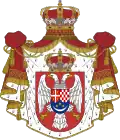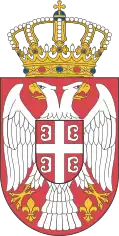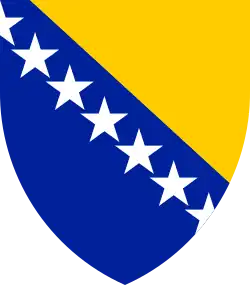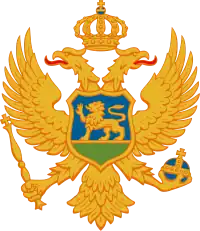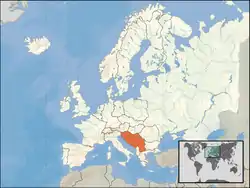
.svg.png.webp) |
|---|
Foreign relations of Yugoslavia were international relations of the interwar Kingdom of Yugoslavia and the Cold War Socialist Federal Republic of Yugoslavia. During its existence, the country was the founding member of numerous multilateral organizations including the United Nations, Non-Aligned Movement, International Monetary Fund, Group of 77, Group of 15, Central European Initiative and the European Broadcasting Union.
History
Kingdom of Yugoslavia
The Kingdom of Yugoslavia, ruled by the Serbian Karađorđević dynasty, was formed in 1918 by the merger of the provisional State of Slovenes, Croats and Serbs (itself formed from territories of the former Austria-Hungary, encompassing Bosnia and Herzegovina and most of Croatia and Slovenia) and Banat, Bačka and Baranja (that had been part of the Kingdom of Hungary within Austria-Hungary) with the formerly independent Kingdom of Serbia. In the same year, the Kingdom of Montenegro also proclaimed its unification with Serbia, whereas the regions of Kosovo and Vardar Macedonia had become parts of Serbia prior to the unification.[1] The first country in the world to officially recognize the new state was the United States.[2] After the creation of Yugoslavia the newly formed state was a status quo state in Europe which was opposed to revisionist states.[3] In this situation the country prominently was a part of the Little Entente and the first Balkan Pact. Yugoslav accession to the Tripartite Pact resulted in Yugoslav coup d'état and ultimately the Invasion of Yugoslavia.
World War II
During the World War II in Yugoslavia the country was formally represented by the Yugoslav government-in-exile while Yugoslav Partisans headed by Josip Broz Tito progressively gained support of the Allies. At the same time the Anti-Fascist Council for the National Liberation of Yugoslavia challenged the authority of the government in exile and among other issues proposed a review of country's international legal obligations with the aim of annulment or re-negotiation.[4] The new foreign policy was based on the pre-war and war era foreign policy positions of the Communist Party of Yugoslavia which included support for the Soviet Union, Bavarian Soviet Republic, Hungarian Soviet Republic, Yugoslav support for the Spanish Republic, rejection of Anschluss and vocal support for Czechoslovakia’s independence after Munich Agreement.[4] The new socialist Federal Executive Council of Josip Broz Tito was formed on 7 March 1945, recognized by United Kingdom on 20 March 1945, and the Soviet Union and the United States a week after that.[4]
Socialist Yugoslavia

During the first post-war years new Yugoslav state was closely aligned with the Soviet Union and involved into dispute over the Free Territory of Trieste and the Greek Civil War. In May 1945, 4,650 Greek refugees, mostly male members of ELAS, settled in the village of Maglić with the help of Yugoslav government. From 1945 to 1948, it was a sui generis case of Greek extraterritorial jurisdiction.[5] This period was sharply ended in 1948 after the Tito–Stalin split.
Yugoslavia initially pursued development of relations among non-bloc neutral European states as a way to avoid isolation and preserve certain level of independence without alienating major powers. In this period Yugoslavia joined the Second Balkan Pact. Belgrade however perceived that in deeply divided Europe there was shrinking maneuvering space for neutral countries and followed the development of what will be called process of Finlandization with great concern. In 1956 the Belgrade declaration ended the period of significant dependence on the Western bloc. The Declaration guaranteed noninterference in Yugoslavia’s internal affairs and legitimized right to different forms of socialist development in different countries.[6] While the declaration failed in achieving lasting rapprochement between the two countries (result of the Yugoslav anxiety over the Hungarian Revolution of 1956) it had an effect on Yugoslav disengagement from the Balkan Pact with NATO member states of Turkey and Greece.[7]
Yugoslavia subsequently discovered new allies among former colonies and mandate territories beyond Europe.[8] Yugoslavia supported Egypt during the Suez Crisis. Yugoslavia developed its relations with India beginning with the time of their concurrent mandate at the UN Security Council from the end of 1949 onward.[9] Yugoslavia was one of the founding members of the Non-Aligned Movement which enabled this comparatively small and underdeveloped country to play one of the most prominent diplomatic role during the Cold War.
Yugoslav crisis which escalated into breakup of the country and Yugoslav Wars turned into one of the major policy and security issues in the first decade after the end of the Cold War.
Federal Secretaries of Foreign Affairs
 Stanoje Simić
Stanoje Simić
(1 February 1946 – 31 August 1948) Edvard Kardelj
Edvard Kardelj
(31 August 1948 – 15 January 1953).jpg.webp) Koča Popović
Koča Popović
(15 January 1953 – 23 April 1965).jpg.webp) Marko Nikezić
Marko Nikezić
(23 April 1965 – 25 December 1968).jpg.webp) Mirko Tepavac
Mirko Tepavac
(25 April 1969 – 1 November 1972).jpg.webp) Miloš Minić
Miloš Minić
(16 December 1972 – 17 May 1978).jpg.webp) Josip Vrhovec
Josip Vrhovec
(17 May 1978 – 17 May 1982).jpg.webp) Lazar Mojsov
Lazar Mojsov
(17 May 1982 – 15 May 1984)_(cropped).jpg.webp) Raif Dizdarević
Raif Dizdarević
(15 May 1984 – 30 December 1987) Budimir Lončar
Budimir Lončar
(31 December 1987 – 12 December 1991)
Foreign relations
Africa
| Country | Independence | Formal Relations Began | Notes |
|---|---|---|---|
| 5 July 1962[10] | 2 July 1962[10] | ||
| 11 November 1975[10] | 1975[10] | ||
| 1 August 1960[10] | 1962[10] | ||
| 30 September 1966[10] | 1970[10] | ||
| 5 August 1960[10] | 1968[10] | ||
| 1 July 1962[10] | 1962[10] | ||
| 1 January 1960[10] | 1960[10] | ||
| 5 July 1975[10] | 1975[10] | ||
| 13 August 1960[10] | 1960[10] | ||
| 11 August 1960[10] | 1966[10] | ||
| 30 June 1960[10] | 1961[10] | ||
| 15 August 1960[10] | 1964[10] | ||
| 27 June 1977[10] | 1978[10] | ||
| 28 February 1922[10] | 1 February 1908 (continued relations of the Kingdom of Serbia)[10] | ||
| 12 October 1968[10] | 1970[10] | ||
| never colonized in a classical sense (temporary Italian occupation)[10] | 1952[10] | ||
| 17 August 1960[10] | 1960[10] | ||
| 18 February 1965[10] | 1965[10] | ||
| 6 March 1957[10] | 1959[10] | ||
| 2 October 1958[10] | 1958[10] | ||
| 10 September 1974[10] | 1975[10] | ||
| 7 August 1960[10] | 1968[10] | ||
| 12/20 December 1963[10] | 1963[10] | ||
| 4 October 1966[10] | 1972[10] | ||
| 26 July 1847[10] | 1959[10] | ||
| 24 December 1951[10] | 1955[10] | ||
| 26 June 1960[10] | 1960[10] | ||
| 22 September 1960[10] | 1961[10] | ||
| 28 November 1960[10] | 1961[10] | ||
| 2 March 1956[10] | 2 March 1957[10] | ||
| 12 March 1968[10] | 1969[10] | ||
| 25 June 1975[10] | 1975[10] | ||
| 21 March 1990[10] | 1990[10] | ||
| 1 October 1960[10] | 1960[10] | ||
| 1 July 1962[10] | 1971[10] | ||
| 28 November 1984[11] | |||
| 12 July 1975[10] | 1977[10] | ||
| 29 June 1976[10] | 1977[10] | ||
| 20 August 1960[10] | 1961[10] | ||
| 27 April 1961[10] | 1961[10] | ||
| 1 July 1960[10] | 1960[10] | ||
| 1 January 1956[10] | 1956[10] | ||
| 6 September 1968[10] | 1968[10] | ||
| 1961, 26 April 1964 (unification)[10] | 1961[10] | ||
| 27 April 1960[10] | 1960[10] | ||
| 20 March 1956[10] | 1957[10] | ||
| 9 October 1962[10] | 1963[10] | ||
| 24 October 1964[10] | 1964[10] | ||
| 18 April 1980[10] | 1980[10] | ||
Americas
| Country | Formal Relations | Notes |
|---|---|---|
| 29 February 1928[12] | ||
| 1952[13] | ||
| 1938[14] | ||
| 9 February 1942[15] | ||
| 1935[16] | ||
| 1966[17] | ||
| 1952[18] | ||
| 1943[19] | ||
| 1 March 1912 (continued relations of the Kingdom of Serbia)[20] | ||
| 1956[21] | ||
| 1956[22] | ||
| 29 June 1978[23] | ||
| 1882 (continued relations of the Kingdom of Serbia)[24] | ||
| 5 November 1968[25] | ||
| 1956[26] | ||
| 1904 (continued relations of the Kingdom of Serbia)[27] | ||
| October 1968[28] | ||
| 24 May 1946[29] | ||
| 23 February 1904 (continued relations of the Kingdom of Serbia)[30] | ||
| 1953[31] | ||
| 1950[32] | ||
| 1942[28] |
Both countries established diplomatic relations on October 1942, and renewed them in 1968. An embassy was opened in Belgrade that same year, with the first Peruvian Ambassador arriving in 1969. | |
| 9 July 1976[33] | ||
| 1965[34] | ||
| 1950[35] | ||
| 1951[36] | ||
Asia-Pacific
| Country | Formal Relations Began | Notes |
|---|---|---|
| 30 December 1954[37] | ||
| 1966[38] | ||
| 20 November 1956[39] | ||
| 29 December 1950[40] | ||
| 15 July 1956[41] | ||
| 2 January 1955[42] | ||
| 1976[43] | ||
| 5 December 1948[44] | ||
| 1954[45] | ||
| 1945[46] | ||
| 1958[47] | ||
| 19 May 1948[lower-alpha 1][48] | ||
| 1951[49] | ||
| 7 May 1963[50] | ||
| 25 November 1962[51] | ||
| 1946[52] | ||
| 1967[53] | ||
| 20 November 1956[54] | ||
| 7 October 1959[55] | ||
| 1951[56] | ||
| 30 October 1948 | ||
| 1974[57] | ||
| 1989[58][lower-alpha 2] | ||
| 18 May 1948[59] | ||
| 1972[60] | ||
| N/a | Saudi Arabia and Yugoslavia did not have diplomatic relations. | |
| 22 August 1967[61] | ||
| 27 December 1982 | ||
| 14 October 1957[62] | ||
| 1946[63] | ||
| 1954[64] | ||
| 10 March 1957[65][66] | ||
| 1957[67] | ||
Europe
| Country | Formal Relations Began | Notes |
|---|---|---|
| 10 July 1960[68] | ||
| 1918[69] | ||
| 1917 (continued relations of the Kingdom of Serbia)[70] | ||
| 1928[71] | ||
| 15 October 1957[72] | ||
| 1920 [73][lower-alpha 3] | ||
| 1977[74] | ||
| 1917 (continued relations of the Kingdom of Serbia)[75] | ||
| 1927[76] | ||
| 6 January 1969[77] | ||
| 26 January 1919[78] | ||
| 19 October 1917 (continued relations of the Kingdom of Serbia)[79][lower-alpha 4] | ||
| 19 December 1945 | ||
| 1919[81] | ||
See also
- Ministry of Foreign Affairs (Yugoslavia)
- List of international trips made by Josip Broz Tito
- Foreign relations of Bosnia and Herzegovina
- Foreign relations of Croatia
- Foreign relations of Montenegro
- Foreign relations of North Macedonia
- Foreign relations of Serbia
- Foreign relations of Slovenia
- Non-Aligned News Agencies Pool
References
- ↑ Formal relations were cut in 1967 following the Six-Day War
- ↑ Yugoslavia recognised Palestine on 16 November 1988
- ↑ Concordat signed in 1914[73]
- ↑ Portugal recognised the Socialist Federal Republic of Yugoslavia in 1974 following the Carnation Revolution[80]
- ↑ "Yugoslavia from a Historical Perspective" (PDF). YU Historija. Retrieved 7 December 2020.
- ↑ Steiner, Zara (2005). The lights that failed : European international history, 1919-1933. Oxford: Oxford University Press. ISBN 978-0-19-151881-2. OCLC 86068902.
- ↑ Sheperd, David (1968). Relations between Yugoslavia and Bulgaria, 1918-1941 (Master Thesis). Durham University. Retrieved 9 January 2021.
- 1 2 3 Đukanović, Dragan; Dašić, Marko (2020). "Effects of the Ideas of the October Revolution in Russia on the Foreign Policy of Yugoslavia in the Period 1945–1947". Journal of Balkan & Near Eastern Studies. 22 (2): 259–274. doi:10.1080/19448953.2018.1556449.
- ↑ Nemanja Mitrović (3 August 2020). "Tito, Jugoslavija i Grčka: Buljkes, "država u državi" kod Novog Sada". BBC. Retrieved 2 February 2021.
- ↑ Milorad Lazić (4 December 2017). "The Soviet Intervention that Never Happened". Wilson Center. Retrieved 26 August 2021.
- ↑ Petar Žarković (n.d.). "Yugoslavia and the USSR 1945 - 1980: The History of a Cold War Relationship". YU historija. Retrieved 26 August 2021.
- ↑ Trültzsch, Arno. "An Almost Forgotten Legacy: Non-Aligned Yugoslavia in the United Nations and in the Making of Contemporary International Law".
- ↑ Mišković, Nataša (2009). "The Pre-history of the Non-Aligned Movement: India's First Contacts with the Communist Yugoslavia, 1948–50" (PDF). India Quarterly. 65 (2): 185–200. doi:10.1177/097492840906500206. S2CID 154101021.
- 1 2 3 4 5 6 7 8 9 10 11 12 13 14 15 16 17 18 19 20 21 22 23 24 25 26 27 28 29 30 31 32 33 34 35 36 37 38 39 40 41 42 43 44 45 46 47 48 49 50 51 52 53 54 55 56 57 58 59 60 61 62 63 64 65 66 67 68 69 70 71 72 73 74 75 76 77 78 79 80 81 82 83 84 85 86 87 88 89 90 91 92 93 94 95 96 Radina Vučetić; Pol Bets; Radovan Cukić; Ana Sladojević (2017). Tito u Africi: slike solidarnosti (PDF). Museum of Yugoslavia. ISBN 978-86-84811-45-7.
- ↑ "RECONOCIMIENTOS DE LA RASD - Reconnaissances de la RASD - Recognitions of the SADR". Universidad de Santiago de Compostela. Retrieved 13 November 2020.
- ↑ "Bilateral relations - Argentina". Ministry of Foreign Affairs (Serbia). Retrieved 7 March 2022.
- ↑ "Bilateral relations - Bolivia". Ministry of Foreign Affairs (Serbia). Retrieved 7 March 2022.
- ↑ Teodosić, Dragan (2019). БЕОГРАД – БРАЗИЛИЈА 80 година дипломатских односа/BELGRADE – BRASÍLIA 80 years of diplomatic relations (in Serbian and English). Belgrade: Archives of Yugoslavia. ISBN 978-86-80099-77-4.
- ↑ DeLong, Linwood (2020). "A Guide to Canadian Diplomatic Relations 1925-2019". Canadian Global Affairs Institute. Retrieved 25 September 2020.
- ↑ "Bilateral relations - Chile". Ministry of Foreign Affairs (Serbia). Retrieved 7 March 2022.
- ↑ "Bilateral relations - Colombia". Ministry of Foreign Affairs (Serbia). Retrieved 7 March 2022.
- ↑ "Bilateral relations - Costa Rica". Ministry of Foreign Affairs (Serbia). Retrieved 7 March 2022.
- ↑ Marina Perović. "Izlaganje ambasadora Marine Perović Petrović povodom 70. godišnjice uspostavljanja diplomatskih odnosa Srbije i Kube, augusta 1943". The Embassy of the Republic of Serbia in Havana. Retrieved 23 February 2021.
- ↑ "Bilateral relations - Dominican Republic". Ministry of Foreign Affairs (Serbia). Retrieved 7 March 2022.
- ↑ "Bilateral relations - Ecuador". Ministry of Foreign Affairs (Serbia). Retrieved 7 March 2022.
- ↑ "Bilateral relations - El Salvador". Ministry of Foreign Affairs (Serbia). Retrieved 7 March 2022.
- ↑ "Bilateral relations - Grenada". Ministry of Foreign Affairs (Serbia). Retrieved 7 March 2022.
- ↑ "Bilateral relations - Guatemala". Ministry of Foreign Affairs (Serbia). Retrieved 7 March 2022.
- ↑ "Bilateral relations - Guyana". Ministry of Foreign Affairs (Serbia). Retrieved 7 March 2022.
- ↑ "Bilateral relations - Haiti". Ministry of Foreign Affairs (Serbia). Retrieved 7 March 2022.
- ↑ "Bilateral relations - Honduras". Ministry of Foreign Affairs (Serbia). Retrieved 7 March 2022.
- 1 2 Foreign Assistance and Related Agencies Appropriations for 1972: Hearings Before a Subcommittee of the Committee on Appropriations, House of Representatives, Ninety-second Congress, First Session. U.S. Government Printing Office. 1971. p. 840.
- ↑ "MANUAL DE ORGANIZACIÓN DE LA EMBAJADA DE MÉXICO EN LA REPÚBLICA DE SERBIA" (PDF). Director General de Programación, Organización y Presupuesto. Retrieved 13 November 2020.
- ↑ "Bilateral relations - Nicaragua". Ministry of Foreign Affairs (Serbia). Retrieved 7 March 2022.
- ↑ "Bilateral relations - Panama". Ministry of Foreign Affairs (Serbia). Retrieved 7 March 2022.
- ↑ "Bilateral relations - Paraguay". Ministry of Foreign Affairs (Serbia). Retrieved 7 March 2022.
- ↑ "Bilateral relations - Suriname". Ministry of Foreign Affairs (Serbia). Retrieved 7 March 2022.
- ↑ Glassner, Martin Ira (1970). "The Foreign Relations of Jamaica and Trinidad and Tobago, 1960-1965". Caribbean Studies (UPR). 10 (3): 116–153. Retrieved 1 November 2020.
- ↑ "Bilateral relations - Uruguay". Ministry of Foreign Affairs (Serbia). Retrieved 7 March 2022.
- ↑ "Bilateral Issues: Venezuela". Ministry of Foreign Affairs (Serbia). Retrieved 7 March 2022.
- ↑ "Bilateral relations - Afghanistan". Ministry of Foreign Affairs (Serbia). Retrieved 7 March 2022.
- ↑ "Serbia country brief". Department of Foreign Affairs and Trade. Retrieved 22 November 2020.
- ↑ "Bilateral relations - Bangladesh". Ministry of Foreign Affairs (Serbia). Retrieved 7 March 2022.
- ↑ "Bilateral relations - Myanmar". Ministry of Foreign Affairs (Serbia). Retrieved 7 March 2022.
- ↑ "Bilateral relations - Cambodia". Ministry of Foreign Affairs (Serbia). Retrieved 7 March 2022.
- ↑ "Bilateral relations - China". Ministry of Foreign Affairs (Serbia). Retrieved 7 March 2022.
- ↑ "Bilateral Issues: New Zealand". Ministry of Foreign Affairs (Serbia). Retrieved 7 March 2022.
- ↑ Jakovina, Tvrtko. "Yugoslavia on the International Scene: The Active Coexistence of Non-Aligned Yugoslavia". YU Historija. Retrieved 1 November 2020.
- ↑ "Bilateral Issues: Indonesia". Ministry of Foreign Affairs (Serbia). Retrieved 29 August 2020.
- ↑ Jelena Maksimović (9 January 2020). "Iran i Srbija: Odnosi srdačni, ali skromni uz izvesne diplomatske usluge". BBC. Retrieved 20 February 2021.
- ↑ "Bilateral relations - Iraq". Ministry of Foreign Affairs (Serbia). Retrieved 7 March 2022.
- ↑ "Virtual Jewish World: Yugoslavia". Jewish Virtual Library. 2008. Retrieved 29 December 2020.
- ↑ "Bilateral relations - Jordan". Ministry of Foreign Affairs (Serbia). Retrieved 7 March 2022.
- ↑ "Bilateral relations - Kuwait". Ministry of Foreign Affairs (Serbia). Retrieved 7 March 2022.
- ↑ "Bilateral relations - Laos". Ministry of Foreign Affairs (Serbia). Retrieved 7 March 2022.
- ↑ "Bilateral relations - Lebanon". Ministry of Foreign Affairs (Serbia). Retrieved 7 March 2022.
- ↑ "Bilateral Issues: Malaysia". Ministry of Foreign Affairs (Serbia). Retrieved 7 March 2022.
- ↑ "Bilateral relations - Mongolia". Ministry of Foreign Affairs (Serbia). Retrieved 7 March 2022.
- ↑ "Bilateral relations - Nepal". Ministry of Foreign Affairs (Serbia). Retrieved 7 March 2022.
- ↑ "Bilateral Issues: New Zealand". Ministry of Foreign Affairs (Serbia). Retrieved 7 March 2022.
- ↑ "Bilateral relations - Oman". Ministry of Foreign Affairs (Serbia). Retrieved 7 March 2022.
- ↑ "Bilateral relations - Palestine". Ministry of Foreign Affairs (Serbia). Retrieved 7 March 2022.
- ↑ Marko Jelić. "Обележен Национални дан Пакистана у Београду". Kuća dobrih vesti. Retrieved 25 September 2020.
- ↑ "Bilateral relations - Philippines". Ministry of Foreign Affairs (Serbia). Retrieved 7 March 2022.
- ↑ "Bilateral relations - Singapore". Ministry of Foreign Affairs (Serbia). Retrieved 7 March 2022.
- ↑ "Bilateral relations - Sri Lanka". Ministry of Foreign Affairs (Serbia). Retrieved 7 March 2022.
- ↑ "Bilateral relations - Syria". Ministry of Foreign Affairs (Serbia). Retrieved 7 March 2022.
- ↑ "Bilateral relations - Thailand". Ministry of Foreign Affairs (Serbia). Retrieved 7 March 2022.
- ↑ "Bilateral relations - Vietnam". Ministry of Foreign Affairs (Serbia). Retrieved 7 March 2022.
- ↑ "Vietnam values traditional ties with Serbia: PM". People's Army Newspaper. 9 September 2017. Retrieved 5 December 2020.
- ↑ "Bilateral relations - Yemen". Ministry of Foreign Affairs (Serbia). Retrieved 7 March 2022.
- ↑ "The Embassy". Embassy of The Republic of Cyprus in Belgrade. 2019. Retrieved 23 August 2020.
- ↑ "Bilateral Issues: Czechia". Ministry of Foreign Affairs (Serbia). Retrieved 8 March 2022.
- ↑ "Bilateral Issues: Denmark". Ministry of Foreign Affairs (Serbia). Retrieved 8 March 2022.
- ↑ "Bilateral Issues: Finland". Ministry of Foreign Affairs (Serbia). Retrieved 25 August 2020.
- ↑ Akrap, Gordan (2011). "Suradnja izvještajno-sigurnosnih sustava DDR-a i SFRJ". National security and the future. 12 (1–2): 11–33.
- 1 2 Ninčević, Marjan Marino (2016). "Diplomatski odnosi Vatikana i Kraljevine Jugoslavije: konkordat iz 1935. godine". Nova prisutnost: časopis za intelektualna i duhovna pitanja. XIV (2): 299–307. Retrieved 9 February 2021.
- ↑ "Bilateral Issues: Ireland". Ministry of Foreign Affairs (Serbia). Retrieved 8 March 2022.
- ↑ "Bilateral Issues: Latvia". Ministry of Foreign Affairs (Serbia). Retrieved 8 March 2022.
- ↑ "Bilateral Issues: Luxembourg". Ministry of Foreign Affairs (Serbia). Retrieved 8 March 2022.
- ↑ "Bilateral Issues: Malta". Ministry of Foreign Affairs (Serbia). Retrieved 7 March 2022.
- ↑ Latinović, Goran (2014). "Југословенско-норвешки односи (1920–1941)" [Yugoslav-Norwegian Relations (1920-1941)] (PDF). Tokovi istorije (in Serbian) (2): 47–54.
- ↑ Gerhard Schulz (1972). Revolutions and peace treaties, 1917-1920. Methuen. p. 35.
- ↑ Lester A. Sobel, Christ Hunt (1976). Portuguese revolution, 1974-76. Facts on File. p. 76. ISBN 0-87196-223-3.
- ↑ "Bilateral relations Switzerland–Serbia". eda.admin.ch. Federal Department of Foreign Affairs. Retrieved 7 March 2022.
